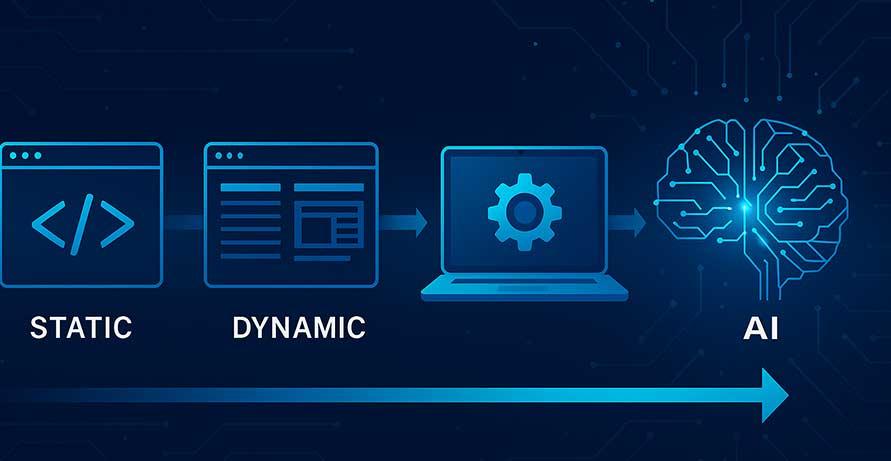The Evolution of Web Development: From Static Sites to AI Automation

Web development has transformed dramatically over the past three decades. What began as simple static web pages in the early 1990s has evolved into dynamic, interactive, and AI-driven experiences that power the digital economy. In 2025, websites are no longer just information tools; they are intelligent platforms that adapt, predict, and automate.
This blog explores the key stages of web development’s evolution, from HTML-based static pages to AI-powered automation, and how modern businesses are leveraging new technologies to stay ahead. You will also learn how Anchor Points helps organizations build future-ready web ecosystems that combine performance, intelligence, and scalability.
The Early Web: Static Sites and Simplicity
In the beginning, websites were purely static. Developers wrote HTML manually, and each page existed as a standalone file. The focus was on content display, not interactivity. These sites served as online brochures for companies and provided basic information.
Key Characteristics of Static Sites:
- Built using HTML, CSS, and minimal JavaScript
- No backend or database connectivity
- Manual updates required for every content change
- Slow scalability for large or frequently updated sites
While these websites were simple and fast to load, they lacked user engagement. Updates were time-consuming, and companies had to rely on developers for even the smallest content edits.
Author’s Expert Viewpoint:
At Anchor Points we often compare static sites to digital posters, easy to publish but hard to maintain. They marked the birth of the web but not its true potential.
The Rise of Dynamic Websites and CMS Platforms
The next big leap came with server-side scripting and databases. Technologies like PHP, ASP.NET, and MySQL enabled websites to fetch and display content dynamically. This era gave birth to early Content Management Systems (CMS) like Drupal, WordPress, and Joomla.
Dynamic websites allowed non-technical users to update content easily, manage media, and create new pages without coding. They also introduced user accounts, shopping carts, and database-driven blogs, paving the way for e-commerce and community platforms.
Key Features Introduced:
- Dynamic page generation through backend logic
- User authentication and admin dashboards
- Integration with third-party systems such as payment gateways and CRMs
- Reusable templates and modules for faster development
This was the era when businesses realized the internet was more than a digital brochure; it was an interactive business engine.
Anchor Points Integration:
Our Drupal and WordPress specialists continue to modernize these dynamic platforms. We help U.S. businesses migrate legacy CMS websites to current versions with better performance, SEO, and security.
Author’s Viewpoint:
Dynamic websites democratized the web. They gave control back to businesses and marked the start of web development as a scalable service industry.
The JavaScript Revolution: Interactive Web Applications
The early 2010s marked a turning point. Users wanted faster, app-like experiences. Enter JavaScript frameworks such as Angular, React, and Vue.js. This era blurred the line between websites and applications.
The modern web became asynchronous, meaning users no longer had to refresh pages to see updates. JavaScript allowed developers to build Single Page Applications (SPAs), real-time dashboards, and interactive interfaces.
Technological Shifts:
- Adoption of AJAX and APIs for real-time data exchange
- Growth of frontend frameworks (React, Vue, Angular)
- Progressive Web Apps (PWAs) for mobile-like performance
- Headless CMS architecture separating frontend and backend
E-commerce, social networks, and SaaS products flourished under this model. Websites now provided dynamic functionality, from live chat to instant search, all powered by JavaScript and APIs.
Anchor Points Integration:
We build headless web applications using React, Next.js, and Laravel APIs, ensuring fast load speeds, seamless UX, and future scalability.
Author’s Viewpoint:
The JavaScript revolution turned websites into living systems. For the first time, web apps began to rival native mobile apps in speed and interactivity.
The Cloud Era: Scalable and Distributed Development
As web traffic grew, scalability became the next frontier. Traditional hosting struggled with sudden spikes, leading to downtime and poor performance. The cloud computing revolution changed everything.
Platforms like AWS, Google Cloud, and Azure allowed websites to scale automatically based on demand. Developers adopted microservices and containerization to break monolithic applications into smaller, manageable components.
Key Advancements:
- Cloud-based hosting and serverless functions
- Continuous Integration and Continuous Deployment (CI/CD) pipelines
- API-driven development for modular scalability
- Global Content Delivery Networks (CDNs) for faster load times
Cloud infrastructure also improved disaster recovery, security compliance, and cost efficiency. Developers could now deploy updates instantly and monitor performance across multiple regions.
Anchor Points Integration:
We migrate traditional websites to cloud-native architectures, combining serverless hosting, automated deployment, and monitoring. Our DevOps experts ensure zero downtime and top performance for high-traffic U.S. businesses.
Author’s Viewpoint:
The cloud made scalability accessible. It turned web development into a continuous, data-driven process rather than a one-time project.
Mobile-First Development and Responsive Design
The mobile boom transformed how websites were designed. With mobile users surpassing desktop users globally, Google introduced mobile-first indexing, ranking mobile-optimized sites higher in search results.
This shift forced developers to prioritize responsive design, ensuring content looked great on any device. Frameworks like Bootstrap and Tailwind CSS simplified this process.
Key Trends:
- Fluid layouts and flexible grids
- Mobile-first design principles
- Touch-friendly UI/UX
- Faster load times for mobile connections
Businesses that failed to adapt saw massive drops in traffic and conversion. Those who embraced responsive design gained SEO advantages and broader audience reach.
Anchor Points Integration:
We specialize in responsive redesigns that align with Core Web Vitals and mobile-first optimization standards. Our websites consistently achieve top scores on Google PageSpeed Insights.
Author’s Viewpoint:
Mobile-first design reshaped development priorities. It reminded businesses that accessibility and usability are as important as aesthetics.
AI and Automation: The Future of Web Development
Today, artificial intelligence is revolutionizing how websites are designed, developed, and maintained. From AI-assisted coding to content automation, the web is becoming self-optimizing and predictive.
How AI Is Transforming Web Development:
- AI Code Generation: Tools like GitHub Copilot and ChatGPT assist developers in writing and debugging code faster.
- Predictive Personalization: AI algorithms deliver personalized content and product recommendations.
- Chatbots and Virtual Assistants: AI-driven chat interfaces improve customer engagement 24/7.
- Automated Testing and Monitoring: Machine learning predicts bugs and performance issues before they impact users.
- Content Creation and SEO Optimization: AI tools generate blogs, metadata, and images to maintain digital freshness.
AI-powered frameworks are redefining front-end experiences. Websites now learn from user behavior, optimize conversion paths, and even trigger automated marketing workflows.
Anchor Points Integration:
At Anchor Points we integrate AI automation and predictive analytics into client websites. From intelligent chatbots to AI-driven UX personalization, we help U.S. enterprises turn static sites into smart digital ecosystems.
Author’s Viewpoint:
AI is not replacing developers; it is empowering them. The future of web development lies in collaboration between human creativity and machine precision.
From Manual to Autonomous: The Web Development Timeline
The journey began in the early 1990s with simple static HTML pages that displayed basic information. Then, in the 2000s, dynamic websites powered by PHP and MySQL brought interactivity and user accounts. Around 2010, JavaScript frameworks made web applications faster and more interactive, giving rise to the modern web app era.
By the mid-2010s, cloud infrastructure and mobile-first design redefined scalability and accessibility. Today, in 2025, artificial intelligence is steering the web toward automation, personalization, and intelligence-driven architecture, completing the evolution from static to smart.
Author’s Viewpoint:
The history of web development mirrors the history of digital business. Every leap in technology has been about making the web more human, more adaptive, and more intelligent.
How Businesses Benefit from Modern Web Development
Modern websites do far more than present information. They act as digital growth engines that automate workflows, integrate data, and predict customer needs.
Key Business Advantages:
- Improved ROI through automation and analytics
- Seamless scalability with cloud and modular frameworks
- Enhanced personalization powered by AI
- Faster deployment cycles using CI/CD pipelines
- Better compliance with evolving security and privacy laws
Anchor Points Integration:
We bring these advantages together by combining AI automation, headless CMS architecture, and responsive design. Our clients see measurable results in speed, engagement, and conversion.
Author’s Viewpoint:
Web development is no longer about coding pages. It is about crafting intelligent systems that evolve alongside user expectations.
The Next Phase: Autonomous Web Experiences
The next frontier in web development is autonomous design and management. AI-driven platforms are moving toward self-optimizing websites that adjust layout, content, and SEO automatically.
Imagine a future where your site identifies declining conversions and rewrites landing page headlines itself, or where an AI agent schedules performance upgrades without developer intervention.
Technologies like generative AI, AI-driven A/B testing, and adaptive UX are already making this vision possible.
Anchor Points Integration:
We are actively investing in AI automation frameworks that enable continuous optimization for enterprise websites. By combining AI with analytics, we help clients maintain peak performance around the clock.
Author’s Viewpoint:
Autonomous web systems are the logical next step. They will turn websites from digital assets into self-managing entities.
Final Takeaways
The evolution of web development has been a journey from static information to intelligent automation. Each phase, from static to dynamic, mobile, cloud, and AI, has reshaped how businesses interact with users.
For modern enterprises, the challenge is not keeping up with trends but choosing the right technologies that balance speed, security, and intelligence.
At Anchor Points, we help businesses bridge the past and future by developing AI-ready, scalable, and conversion-optimized web solutions. Whether you are modernizing a legacy CMS or building a next-generation web app, our team ensures your digital presence evolves with technology.
Call to Action:
Ready to take your website from static to smart? Contact Anchor Points today to explore how AI-driven development can future-proof your digital strategy.
FAQs
Q1. What is AI automation in web development?
It involves using artificial intelligence to automate coding, testing, content creation, and UX optimization.
Q2. Will AI replace web developers?
No. AI enhances efficiency but still relies on human creativity and strategy.
Q3. What are the benefits of AI in websites?
Faster updates, personalized experiences, predictive analytics, and reduced maintenance costs.
Q4. What technologies power modern web development?
React, Next.js, Laravel, Node.js, and AI frameworks integrated with cloud infrastructure.
Q5. How can businesses modernize existing websites?
By adopting cloud-based hosting, headless CMS, and integrating AI tools for automation and analytics.








